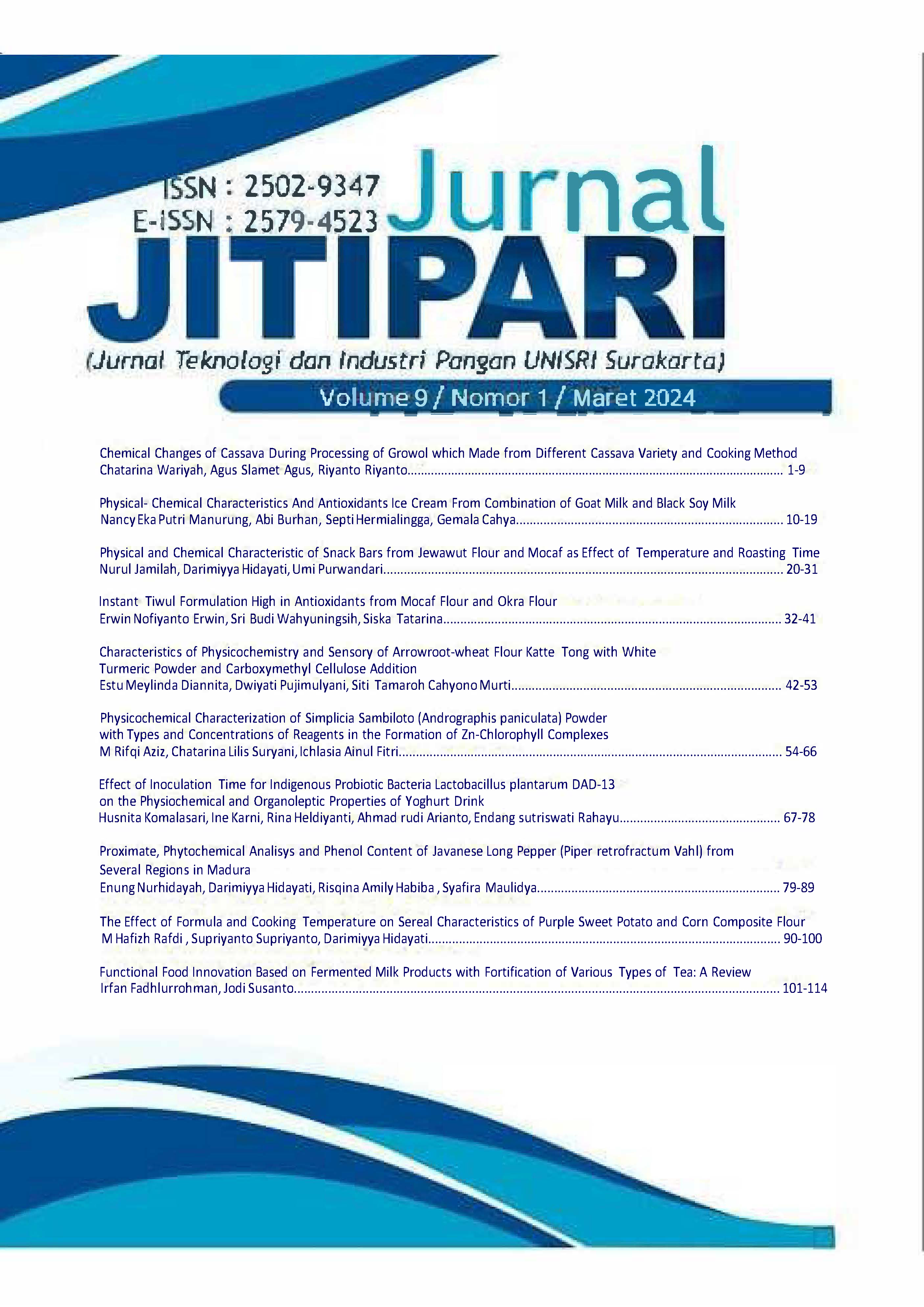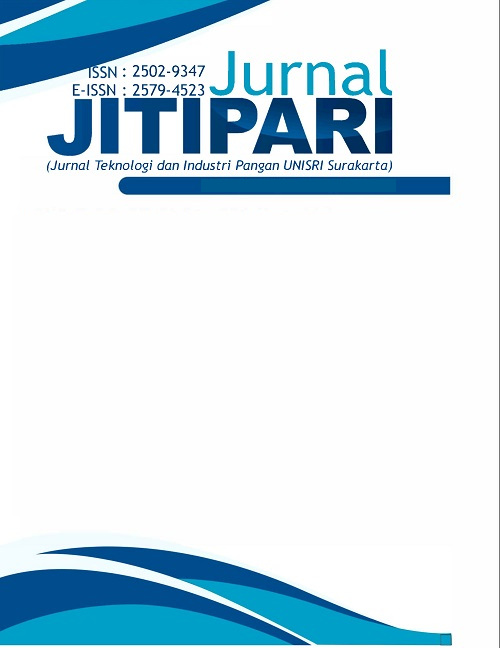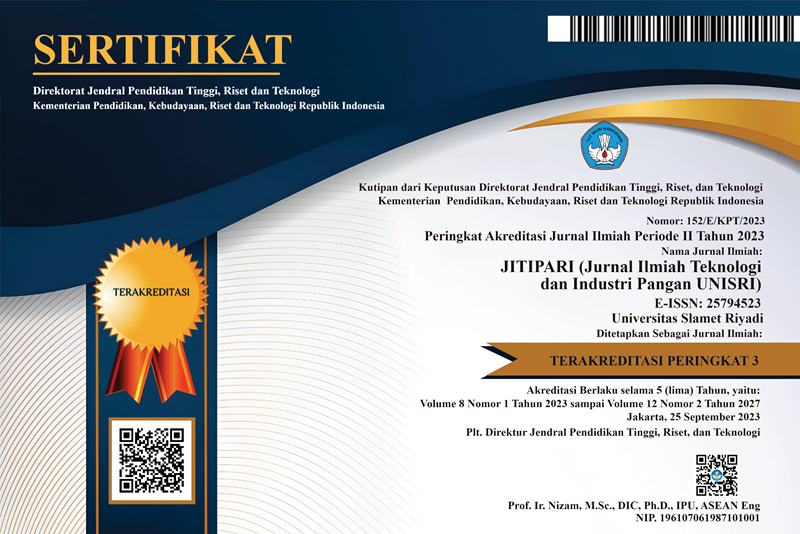Physical and Chemical Characteristic of Snack Bars from Jewawut Flour and Mocaf as Effect of Temperature and Roasting Time
Karakteristik Fisik dan Kimia Snack Bar dari Tepung Jewawut dan Mocaf Sebagai Efek Suhu dan Lama Pemanggangan
DOI:
https://doi.org/10.33061/jitipari.v9i1.9369Abstract
Snack bars are processed food products that shaped rectangular or like a bar. Snack bar in this study used ingredients of barley flour and mocaf. Barley is a potential ingredient as a source of dietary fiber and gluten-free mocaf can fix the texture of barley. One of the factors that affects the quality of the snack bar is the baking process. The purpose of this study was to determine the effect of temperature and baking time on the characteristics of physical, chemical, and sensory of the snack bar, and to determine best formulation of the temperature and baking time of the snack bar. The design applied was a completely randomized design with two factors consisting baking temperature of 130 and 160°C, and baking time of 20 minutes and 40 minutes. The results showed that baking time had a significant effect on the values of a and b, but not significant on the value of L. Baking temperature and time had a significant effect on the level of preference for texture, color, overall and on texture and color on sensory quality. However, it had no significant effect on aroma and taste. The baking temperature had a significant effect on the moisture content, but roasting time had no significant effect. The best snack bar was that baked at 160ºC, 20 minutes. The best formulation of snack bar contains nutrients, water content of 15%, ash of 1.906%, fat 19.447%, protein 21.012%, carbohydrates 42.635%, dietary fiber 11.262% and total calories 429 kcal.
References
Afiifah, N. N., & Srimiati, M. (2020). Analisis proksimat snack bar dengan substitusi tepung pisang kepok (Musa paradisiaca linn) process of snack bar analysis with pisang kepok (Musa paradisaca linn) flour substitution. Jurnal Ilmiah Kesehatan, 2(1), 36–42. https://doi.org/10.36590/jika.v2i1.46. http:ojs.yapenas21maros.ac.id/index.php/jika
Ahmad, I., Ashraf, M., & Saeed, M. K. (2010). Profile analysis (TPA) of cakes supplemented with soy flour. Pakistan Journal of Science, 62(1), 22–26.
Avianty, S., & Ayustaningwarno, F. (2013). Indeks glikemik snack bar ubi jalar kedelai hitam sebagai alternatif makanan selingan penderita diabetes melitus tipe 2. Journal of Nutrition College, 2(4), 622–629.
BPOM. (2016). Peraturan kepala badan pengawas obat dan makanan nomor 13 tahun 2016 tentang pengawasan klaim pada label dan iklan pangan olahan. Badan Pengawasan Obat dan Makanan Republik Indonesia.
da Silva, E. P., Siqueira, H. H., Damiani, C., & Vilas Boas, E. V. de B. (2016). Physicochemical and sensory characteristics of snack bars added of jerivá flour (Syagrus romanzoffiana). Food Science and Technology (Brazil), 36(3), 421–425. https://doi.org/10.1590/1678-457X.08115
Damayanti, S., Inayah, I., & Nurjannah, D. (2021). Analysis of physical properties, properties and proximate conditions of snack bar formulation of red rice flour (Oryza nivara) and ground nuts (Arachis hypogaea, L). Jurnal Keperawatan Respati Yogyakarta, 8(2), 103. https://doi.org/10.35842/jkry.v8i2.603
Hidayat, H., & Insafitri. (2021). Analisa kadar proksimat pada thalassia hemprichi dan galaxaura rugosa di kabupaten bangkalan. Juvenil: Jurnal Ilmiah Kelautan Dan Perikanan, 2(4), 307–317.
Indrastati, N., & Anjani, G. (2016). Snack bar kacang merah dan tepung umbi garut sebagai alternatif makanan selingan dengan indeks Glikemik Rendah. Journal of Nutrition College, 5(4), 546–554.
Kasim, R., Liputo, S. A., Limonu, M., & Mohamad, F. P. (2018). Pengaruh suhu dan lama pemanggangan terhadap tingkat kesukaan dan kandungan gizi snack food bars berbahan dasar tepung pisang goroho dan tepung ampas tahu. Jurnal Technopreneur (Jtech), 6(2), 41–48.
Leader, I. (2004). Sorghum and millets cultivated plants, primarily as food sources. Department of Technology, Central Food Research Institute. Hungary. Encyclopedia of Life Support Systems (EOLSS).
Mahendradatta, M., Laga, A., & Nurhisna, N. I. U. (2020). Study of snack bar combination of banana flour (Musa paradisiaca) and mung bean flour blending as emergency food. IOP Conference Series: Earth and Environmental Science, 486(1). https://doi.org/10.1088/1755-1315/486/1/012054
Mcguire, R. G. (1992). Reporting of objective color measurements. HortScience, 27(12), 1254–1255.
Meilita, Q. (2019). Pengaruh suhu dan waktu pemanggangan dan perbandingan tepung kacang merah dengan tepung talas terhadap karakteristik cookies. Skripsi(S1) thesis, Fakultas Teknik Unpas.
Momanyi, D., Owino, W., & Makokha, A. (2020). Formulation, nutritional and sensory evaluation of baobab based ready-to-eat sorghum and cowpea blend snack bars. Scientific African, 7, e00215. https://doi.org/10.1016/j.sciaf.2019.e00215
Nahdlah, Z. (2010). Karakterisasi tepung singkong (Manihot esculenta, crantz) dan tepung singkong yang dimodifikasi (modified cassava flour/MOCAF) serta aplikasinya pada produk pangan. Skripsi. Jurusan Teknologi Pangan dan Hasil Pertanian Fakultas Teknologi Pertanian Universitas Gadjah Mada Yogyakarta.
Natalia, D. (2010). Sifat fisikokimia dan indeks glikemik berbagai produk snack. Skripsi. Bogor: Insitut Pertanian Bogor.
Olagunju, A. I., Arigbede, T. I., Makanjuola, S. A., & Oyebode, E. T. (2022). Nutritional compositions, bioactive properties, and in-vivo glycemic indices of amaranth-based optimized multigrain snack bar products. Measurement: Food, 7(May), 100039. https://doi.org/10.1016/j.meafoo.2022.100039
Pratama, R. I., Rostini, I., & Liviawaty, E. (2014). Karakteristik biskuit dengan penambahan tepung tulang ikan jangilus ( Istiophorus sp .). Jurnal Akuatika, 5(1), 30–39.
Puspita, W., Sulaeman, A., & Damayanthi, E. (2019). Snack bar berbahan pati sagu ( Metroxylon sp .), tempe , dan beras hitam sebagai pangan fungsional berindeks glikemik rendah Berdasarkan data World Health Organization. Jurnal Gizi Indonesia (The Indonesian Journal of Nutrition), 8(1), 11–23.
RamÃrez-Jiménez, A. K., Gaytán-MartÃnez, M., Morales-Sánchez, E., & Loarca-Piña, G. (2018). Functional properties and sensory value of snack bars added with common bean flour as a source of bioactive compounds. Lwt, 89, 674–680. https://doi.org/10.1016/j.lwt.2017.11.043
Singh, A., Kumari, A., & Chauhan, A. K. (2022). Formulation and evaluation of novel functional snack bar with amaranth, rolled oat, and unripened banana peel powder. Journal of Food Science and Technology, 59(9), 3511–3521. https://doi.org/10.1007/s13197-021-05344-6
Sousa, M. F. de, Guimarães, R. M., Araújo, M. de O., Barcelos, K. R., Carneiro, N. S., Lima, D. S., Santos, D. C. Dos, Batista, K. de A., Fernandes, K. F., Lima, M. C. P. M., & Egea, M. B. (2019). Characterization of corn (Zea mays L.) bran as a new food ingredient for snack bars. Lwt, 101(March 2018), 812–818. https://doi.org/10.1016/j.lwt.2018.11.088
Seftiono, H., Djiuardi, E., & Pricila, S. (2019). Analisis proksimat dan total serat pangan pada crackers fortifikasi tepung tempe dan koleseom (talinumtiangulare). Agritech, 39(2), 160–168.
Septiani, V. E., Jus’at, I., & Wijaya, H. (2016). Pembuatan snack bar bebas gluten dari bahan baku tepung mocaf dan tepung beras pecah kulit. Skripsi Fakultas Ilmu Kesehatan. Universitas Esa Unggul .
SNI. (2006). Petunjuk pengujian organoleptik dan atau sensori nomor 01-2346-2006. Badan Standarisasi Nasional, Jakarta.
Sudarmadji, S., Haryono, B & Suhardi. (2010). Analisis bahan makanan dan pertanian. Yogyakarta:Liberti
USDA. (2015). National nutrient database for standard reference. basic report 25048, snacks, Nutri-Grain Fruit and Nut Bar. The National Agricultural Library, USA.
Zakaria, F. R., Wijaya, S., Haryadi, Y., Thahir, R., & Suismono. (2010). Aplikasi tepung jewawut (Pennicetum glaucum) dan whey tahu untuk memberikan nilai tambah snack bar. Jurnal Penelitian Pascapanen Pertanian, 7(2), 103–109.
da Silva, E. P., Siqueira, H. H., Damiani, C., & Vilas Boas, E. V. de B. (2016). Physicochemical and sensory characteristics of snack bars added of jerivá flour (Syagrus romanzoffiana). Food Science and Technology (Brazil), 36(3), 421–425. https://doi.org/10.1590/1678-457X.08115
Damayanti, S., Inayah, I., & Nurjannah, D. (2021). Analysis of physical properties, properties and proximate conditions of snack bar formulation of red rice flour (Oryza nivara) and ground nuts (Arachis hypogaea, L). Jurnal Keperawatan Respati Yogyakarta, 8(2), 103. https://doi.org/10.35842/jkry.v8i2.603
Mahendradatta, M., Laga, A., & Nurhisna, N. I. U. (2020). Study of snack bar combination of banana flour (Musa paradisiaca) and mung bean flour blending as emergency food. IOP Conference Series: Earth and Environmental Science, 486(1). https://doi.org/10.1088/1755-1315/486/1/012054
Momanyi, D., Owino, W., & Makokha, A. (2020). Formulation, nutritional and sensory evaluation of baobab based ready-to-eat sorghum and cowpea blend snack bars. Scientific African, 7, e00215. https://doi.org/10.1016/j.sciaf.2019.e00215
Olagunju, A. I., Arigbede, T. I., Makanjuola, S. A., & Oyebode, E. T. (2022). Nutritional compositions, bioactive properties, and in-vivo glycemic indices of amaranth-based optimized multigrain snack bar products. Measurement: Food, 7(May), 100039. https://doi.org/10.1016/j.meafoo.2022.100039
RamÃrez-Jiménez, A. K., Gaytán-MartÃnez, M., Morales-Sánchez, E., & Loarca-Piña, G. (2018). Functional properties and sensory value of snack bars added with common bean flour as a source of bioactive compounds. Lwt, 89, 674–680. https://doi.org/10.1016/j.lwt.2017.11.043
Singh, A., Kumari, A., & Chauhan, A. K. (2022). Formulation and evaluation of novel functional snack bar with amaranth, rolled oat, and unripened banana peel powder. Journal of Food Science and Technology, 59(9), 3511–3521. https://doi.org/10.1007/s13197-021-05344-6
Sousa, M. F. de, Guimarães, R. M., Araújo, M. de O., Barcelos, K. R., Carneiro, N. S., Lima, D. S., Santos, D. C. Dos, Batista, K. de A., Fernandes, K. F., Lima, M. C. P. M., & Egea, M. B. (2019). Characterization of corn (Zea mays L.) bran as a new food ingredient for snack bars. Lwt, 101(March 2018), 812–818. https://doi.org/10.1016/j.lwt.2018.11.088
Zulaikha, Y., Yao, S. H., & Chang, Y. W. (2021). Physicochemical and functional properties of snack bars enriched with tilapia (Oreochromis niloticus) by-product powders. Foods, 10(8). https://doi.org/10.3390/foods10081908
Downloads
Published
How to Cite
Issue
Section
License
Copyright (c) 2024 Nurul Jamilah, Darimiyya Hidayati, Umi Purwandari

This work is licensed under a Creative Commons Attribution-ShareAlike 4.0 International License.
Authors who publish this journal agree to the following terms:
- Authors retain copyright and grant the journal right of first publication with the work simultaneously licensed under a Creative Commons Attribution-ShareAlike 4.0 International (CC BY-SA 4.0) that allows others to share the work with an acknowledgement of the work's authorship and initial publication in this journal.
- Authors can separately make additional contractual arrangements for non-exclusive distribution published by the journal (e.g., publish it in a book), with an acknowledgement of its initial publication in this journal.
- Authors are allowed and encouraged to send their work via online (e.g., in the institutional repositories or their website) after published by the journal.










